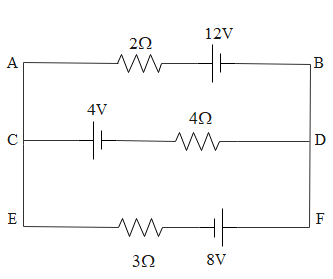
The current in branch CD of given circuit is then:

(A) 0
(B) 1
(C) 2
(D) 3

Answer
567k+ views
Hint
We know that electric current is the movement of electrons through a wire. Electric current is measured in amperes (amps) and refers to the number of charges that move through the wire per second. Current is usually denoted by the symbol I. Ohm's law relates the current flowing through a conductor to the voltage V and resistance R; that is, V = IR. An alternative statement of Ohm's law is I = V/R. The direction of an electric current is by convention the direction in which a positive charge would move. Thus, the current in the external circuit is directed away from the positive terminal and toward the negative terminal of the battery. Based on this concept we have to solve this question
Complete step by step answer
We know that,
Applying Kirchhoff law, in ACBD, we get,
$2 \mathrm{i}+4 \mathrm{i}_{1}=-4+12$
$=>2 \mathrm{i} \quad+\quad 4 \mathrm{i}_{1}=8$
$=>\quad \mathrm{i}+\quad 2 \mathrm{i}_{1}=4 … (1)$
Applying Kirchhoff law in loop CDFE, we get,
$=>\quad-4 \mathrm{i}_{1}+\quad 3\left(\mathrm{i}-\mathrm{i}_{1}\right)=4+8$
$=>\quad-4 \mathrm{i} \quad+\quad 3 \mathrm{i}-3 \mathrm{i}_{1}=12$
$=>\quad 3 \mathrm{i}-7 \mathrm{i}_{1}=12 … (2)$
From (1) and (2)
$ \quad=>\quad 3\left(4-2 \mathrm{i}_{1}\right)-7 \mathrm{i}_{1}=12$
$=>12-6 \mathrm{i}_{1}-7 \mathrm{i}_{1}=12$
$=>\quad-13 \mathrm{i}_{1}=0$
$\Rightarrow \quad \mathrm{i}_{1}=0$
Hence current in branch CD is zero.
Therefore, the correct answer is Option (A).
Note
It is known that mains electricity is the general-purpose alternating-current (AC) electric power supply. It is the form of electrical power that is delivered to homes and businesses. Large transformers are used to run transmission lines at high voltages in order to keep losses to a minimum. But high voltage is dangerous, particularly to life, so bringing it into a house would not be an acceptable risk. DC arcs do not "quench" as easily because voltage does not go through zero. A.C. is said to be four to five times more dangerous than D.C. For one thing, A.C. causes more severe muscular contractions. For another, it stimulates sweating, which lowers the skin resistance. The frequency of the AC has a lot to do with the effect on the human body.
We know that electric current is the movement of electrons through a wire. Electric current is measured in amperes (amps) and refers to the number of charges that move through the wire per second. Current is usually denoted by the symbol I. Ohm's law relates the current flowing through a conductor to the voltage V and resistance R; that is, V = IR. An alternative statement of Ohm's law is I = V/R. The direction of an electric current is by convention the direction in which a positive charge would move. Thus, the current in the external circuit is directed away from the positive terminal and toward the negative terminal of the battery. Based on this concept we have to solve this question
Complete step by step answer
We know that,
Applying Kirchhoff law, in ACBD, we get,
$2 \mathrm{i}+4 \mathrm{i}_{1}=-4+12$
$=>2 \mathrm{i} \quad+\quad 4 \mathrm{i}_{1}=8$
$=>\quad \mathrm{i}+\quad 2 \mathrm{i}_{1}=4 … (1)$
Applying Kirchhoff law in loop CDFE, we get,
$=>\quad-4 \mathrm{i}_{1}+\quad 3\left(\mathrm{i}-\mathrm{i}_{1}\right)=4+8$
$=>\quad-4 \mathrm{i} \quad+\quad 3 \mathrm{i}-3 \mathrm{i}_{1}=12$
$=>\quad 3 \mathrm{i}-7 \mathrm{i}_{1}=12 … (2)$
From (1) and (2)
$ \quad=>\quad 3\left(4-2 \mathrm{i}_{1}\right)-7 \mathrm{i}_{1}=12$
$=>12-6 \mathrm{i}_{1}-7 \mathrm{i}_{1}=12$
$=>\quad-13 \mathrm{i}_{1}=0$
$\Rightarrow \quad \mathrm{i}_{1}=0$
Hence current in branch CD is zero.
Therefore, the correct answer is Option (A).
Note
It is known that mains electricity is the general-purpose alternating-current (AC) electric power supply. It is the form of electrical power that is delivered to homes and businesses. Large transformers are used to run transmission lines at high voltages in order to keep losses to a minimum. But high voltage is dangerous, particularly to life, so bringing it into a house would not be an acceptable risk. DC arcs do not "quench" as easily because voltage does not go through zero. A.C. is said to be four to five times more dangerous than D.C. For one thing, A.C. causes more severe muscular contractions. For another, it stimulates sweating, which lowers the skin resistance. The frequency of the AC has a lot to do with the effect on the human body.
Recently Updated Pages
Master Class 12 Business Studies: Engaging Questions & Answers for Success

Master Class 12 Economics: Engaging Questions & Answers for Success

Master Class 12 English: Engaging Questions & Answers for Success

Master Class 12 Maths: Engaging Questions & Answers for Success

Master Class 12 Social Science: Engaging Questions & Answers for Success

Master Class 12 Chemistry: Engaging Questions & Answers for Success

Trending doubts
What are the major means of transport Explain each class 12 social science CBSE

Which are the Top 10 Largest Countries of the World?

Draw a labelled sketch of the human eye class 12 physics CBSE

How much time does it take to bleed after eating p class 12 biology CBSE

Explain sex determination in humans with line diag class 12 biology CBSE

Differentiate between homogeneous and heterogeneous class 12 chemistry CBSE




